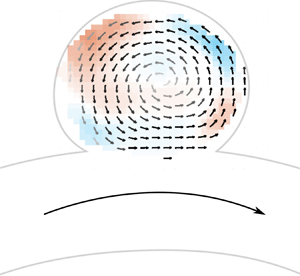Article contents
The effect of Dean, Reynolds and Womersley numbers on the flow in a spherical cavity on a curved round pipe. Part 1. Fluid mechanics in the cavity as a canonical flow representing intracranial aneurysms
Published online by Cambridge University Press: 31 March 2021
Abstract

Flow in sidewall cerebral aneurysms can be ideally modelled as the combination of flow over a spherical cavity and flow in a curved circular pipe, two canonical flows. Flow in a curved pipe is known to depend on the Dean number  $De$, combining the effects of Reynolds number
$De$, combining the effects of Reynolds number  $\textit {Re}$ and of the curvature along the pipe centreline,
$\textit {Re}$ and of the curvature along the pipe centreline,  $\kappa$. Pulsatility in the flow introduces a dependence on the Womersley number
$\kappa$. Pulsatility in the flow introduces a dependence on the Womersley number  $Wo$. Using stereo particle image velocimetry measurements, this study investigated the effect of these three key non-dimensional parameters, by modifying pipe curvature (
$Wo$. Using stereo particle image velocimetry measurements, this study investigated the effect of these three key non-dimensional parameters, by modifying pipe curvature ( $De$), flow rate (
$De$), flow rate ( $Re$) and pulsatility frequency (
$Re$) and pulsatility frequency ( $Wo$), on the flow patterns in a spherical cavity. A single counter-rotating vortex was observed in the cavity for all values of pipe curvature
$Wo$), on the flow patterns in a spherical cavity. A single counter-rotating vortex was observed in the cavity for all values of pipe curvature  $\kappa$ and Reynolds number
$\kappa$ and Reynolds number  $\textit {Re}$, for both steady and pulsatile inflow conditions. Increasing the pipe curvature impacted the flow patterns in both the pipe and the cavity, by shifting the velocity profile towards the cavity opening and increasing the flow rate in to the cavity. The circulation in the cavity was found to collapse well with only the Dean number, for both steady and pulsatile inflows. For pulsatile inflow, the counter-rotating vortex was unstable and the location of its centre over time was impacted by the curvature of the pipe, as well as
$\textit {Re}$, for both steady and pulsatile inflow conditions. Increasing the pipe curvature impacted the flow patterns in both the pipe and the cavity, by shifting the velocity profile towards the cavity opening and increasing the flow rate in to the cavity. The circulation in the cavity was found to collapse well with only the Dean number, for both steady and pulsatile inflows. For pulsatile inflow, the counter-rotating vortex was unstable and the location of its centre over time was impacted by the curvature of the pipe, as well as  $\textit {Re}$ and
$\textit {Re}$ and  $Wo$ in the free stream. The circulation in the cavity was higher for steady inflow than for the equivalent average Reynolds number and Dean number pulsatile inflow, with very limited impact of the Womersley number in the range studied. A second part of this study, that focuses on the changes in fluid dynamics when the intracranial aneurysm is treated with a flow-diverting stent, can be found in this issue (Barbour et al., J. Fluid Mech., vol. 915, 2021, A124).
$Wo$ in the free stream. The circulation in the cavity was higher for steady inflow than for the equivalent average Reynolds number and Dean number pulsatile inflow, with very limited impact of the Womersley number in the range studied. A second part of this study, that focuses on the changes in fluid dynamics when the intracranial aneurysm is treated with a flow-diverting stent, can be found in this issue (Barbour et al., J. Fluid Mech., vol. 915, 2021, A124).
JFM classification
- Type
- JFM Papers
- Information
- Copyright
- © The Author(s), 2021. Published by Cambridge University Press
References
REFERENCES
- 11
- Cited by





